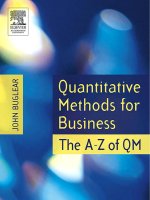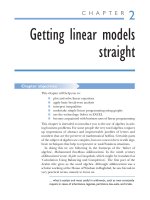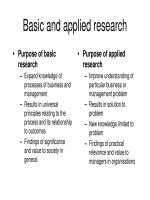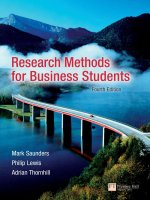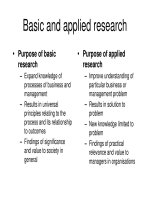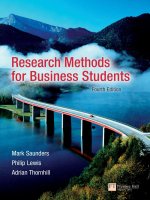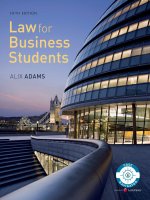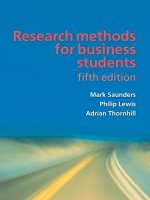Research Methods for Business Students 5th edition
Bạn đang xem bản rút gọn của tài liệu. Xem và tải ngay bản đầy đủ của tài liệu tại đây (16.52 MB, 649 trang )
Research methods
for business
students
fi fth edition
Research methods
for business students
Mark Saunders
Philip Lewis
Adrian Thornhill
fi fth edition
Saunders
●
Lewis
●
Thornhill
So, if you’re thinking …
‘How do I choose my topic?’
‘I’m confused by all these different philosophies…’
‘I’ve got my data; what do I write fi rst?’
… then, open this book to make the most of:
regular checklists and ‘Progressing your Research Project’ sections to give
●
you step-by-step practical guidance on the process
a glossary of clear defi nitions of over 400 research terms
●
cases and examples of student projects and academic research to show
●
you how it’s done
detailed chapters on choosing your topic, reviewing the literature,
●
under standing philosophies, research design, access and ethics,
data collection and analysis, and writing and presenting your research
And, at www.pearsoned.co.uk/saunders, you can get online tutorials on research
software, such as SPSS and NVivo. Plus, search the internet more effi ciently and
effectively with our Smarter Online Searching guide!
Start your research with confi dence and complete it with success.
www.pearson-books.com
Cover photograph: Eastcott Momatiuk/ Getty
Through the course of fi ve editions, Research Methods for
Business Students has guided hundreds of thousands of student
researchers to success in their research proposals, projects and
dissertations.
CVR_SAUND6860_05_SE_CVR.indd 1 26/2/09 18:08:14
Research Methods for Business Students
Visit the Research Methods for Business Students, Fifth Edition
Companion Website at www.pearsoned.co.uk/saunders to find
valuable student learning material including:
■ Multiple choice questions to test your learning.
■ Tutorials on Excel, NVivo and SPSS.
■ Updated research datasets to practice with.
■ Updated additional case studies with accompanying questions.
■ Smarter Online Searching Guide – how to make the most of
the Internet in your research.
A01_SAUN6860_05_SE_FM.QXD 12/2/09 5:39 pm Page i
We work with leading authors to develop the strongest educational
materials in business strategy, bringing cutting-edge thinking and best
learning practice to a global market.
Under a range of well-known imprints, including Financial Times Prentice
Hall, we craft high quality print and electronic publications which help
readers to understand and apply their content, whether studying or at
work.
To find out more about the complete range of our publishing please visit
us on the World Wide Web at: www.pearsoned.co.uk
A01_SAUN6860_05_SE_FM.QXD 12/2/09 5:39 pm Page ii
Research Methods
for Business
Students
Fifth edition
Mark Saunders
Philip Lewis
Adrian Thornhill
A01_SAUN6860_05_SE_FM.QXD 12/2/09 5:39 pm Page iii
Pearson Education Limited
Edinburgh Gate
Harlow
Essex CM20 2JE
England
and Associated Companies throughout the world
Visit us on the World Wide Web at:
www.pearsoned.co.uk
First published under the Pitman Publishing imprint in 1997
Second edition 2000
Third edition 2003
Fourth edition 2007
Fifth edition 2009
© Pearson Professional Limited 1997
© Pearson Education Limited 2000, 2003, 2007
© Mark Saunders, Philip Lewis and Adrian Thornhill 2009
The rights of Mark Saunders, Philip Lewis and Adrian Thornhill to be identified as authors
of this work have been asserted by them in accordance with the Copyright, Designs and
Patents Act 1988.
All rights reserved; no part of this publication may be reproduced, stored in a retrieval
system, or transmitted in any form or by any means, electronic, mechanical, photocopying,
recording or otherwise without either the prior written permission of the publisher or a
licence permitting restricted copying in the United Kingdom issued by the Copyright
Licensing Agency Ltd, Saffron House, 6–10 Kirby Street, London EC1N 8TS.
All trademarks used herein are the property of their respective owners. The use of any
trademark in this text does not vest in the author or publisher any trademark ownership
rights in such trademarks, nor does the use of such trademarks imply any affiliation
with or endorsement of this book by such owners.
ISBN: 978-0-273-71686-0
British Library Cataloguing-in-Publication Data
A catalogue record for this book is available from the British Library
Library of Congress Cataloging-in-Publication Data
Saunders, Mark, 1959-
Research methods for business students / Mark Saunders, Philip Lewis, Adrian Thornhill. —5th ed.
p. cm.
Includes bibliographical references and index.
ISBN 978-0-273-71686-0 (pbk. : alk. paper) 1. Business—Research. 2. Business—Research—Data
processing. I. Lewis, Philip, 1945- II. Thornhill, Adrian. III. Title.
HD30.4.S28 2009
650.072—dc22
2008054877
10 9 8 7 6 5 4 3 2 1
13 12 11 10 09
Typeset in ITC Slimbach Std 9.5/12.5 by 73
Printed and bound by Rotolito Lombarda, Italy
The publisher’s policy is to use paper manufactured from sustainable forests.
A01_SAUN6860_05_SE_FM.QXD 12/2/09 5:39 pm Page iv
v
Brief Contents
How to use this book xvii
Guided tour xxii
Preface xxv
Contributors xxvii
Publisher’s acknowledgements xxix
1 The nature of business and management research
and structure of this book 2
2 Formulating and clarifying the research topic 20
3 Critically reviewing the literature 58
4 Understanding research philosophies and approaches 106
5 Formulating the research design 136
6 Negotiating access and research ethics 168
7 Selecting samples 210
8 Using secondary data 256
9 Collecting primary data through observation 288
10 Collecting primary data using semi-structured, in-depth
and group interviews 318
11 Collecting primary data using questionnaires 360
12 Analysing quantitative data 414
13 Analysing qualitative data 480
14 Writing and presenting your project report 526
Bibliography 561
Appendices 573
Glossary 587
Index 604
A01_SAUN6860_05_SE_FM.QXD 12/2/09 5:39 pm Page v
A01_SAUN6860_05_SE_FM.QXD 12/2/09 5:39 pm Page vi
vii
Contents
How to use this book xvii
Guided tour xxii
Preface xxv
Contributors xxvii
Publisher’s acknowledgements xxix
1 The nature of business and management
research and structure of this book 2
Mark Saunders, Philip Lewis and Adrian Thornhill
Learning outcomes 2
1.1 Introduction 2
1.2 The nature of research 4
1.3 The nature of business and management research 5
1.4 The research process 10
1.5 The purpose and structure of this book 10
1.6 Summary 15
Self-check questions 15
Review and discussion questions 15
References 16
Further reading 16
Case 1: Isabelle’s research dilemma 17
Michael Savvas
Self-check answers 18
2 Formulating and clarifying
the research topic 20
Mark Saunders, Philip Lewis and Adrian Thornhill
Learning outcomes 20
2.1 Introduction 20
2.2 Attributes of a good research topic 22
2.3 Generating and refining research ideas 24
2.4 Turning research ideas into research projects 32
A01_SAUN6860_05_SE_FM.QXD 12/2/09 5:39 pm Page vii
viii
2.5 Writing your research proposal 41
2.6 Summary 48
Self-check questions 49
Review and discussion questions 49
Progressing your research project: from research ideas
to a research proposal 50
References 50
Further reading 51
Case 2: Media climate change reporting and environmental
disclosure patterns in the low-cost airline industry
in the twenty-first century 52
Richard Slack
Self-check answers 55
3 Critically reviewing the literature 58
Mark Saunders, Philip Lewis and Adrian Thornhill
Learning outcomes 58
3.1 Introduction 58
3.2 The critical review 61
3.3 Literature sources available 68
3.4 Planning your literature search strategy 75
3.5 Conducting your literature search 80
3.6 Obtaining and evaluating the literature 92
3.7 Recording the literature 94
3.8 Plagiarism 97
3.9 Summary 98
Self-check questions 99
Review and discussion questions 100
Progressing your research project: critically reviewing
the literature 100
References 100
Further reading 102
Case 3: Complexity theory and emergent change 102
Mike Wallace and Alison Wray
Self-check answers 104
4 Understanding research philosophies
and approaches 106
Mark Saunders, Philip Lewis and Adrian Thornhill
Learning outcomes 106
4.1 Introduction 106
Contents
A01_SAUN6860_05_SE_FM.QXD 12/2/09 5:39 pm Page viii
ix
4.2 Understanding your research philosophy: why research
philosophy is important 107
4.3 Research approaches 124
4.4 Summary 128
Self-check questions 129
Review and discussion questions 129
Progressing your research project: diagnosing your
research philosophy 130
References 131
Further reading 131
Case 4: Consultancy research for a not-for-profit organisation 132
Karen Handley
Self-check answers 134
5 Formulating the research design 136
Mark Saunders, Philip Lewis and Adrian Thornhill
Learning outcomes 136
5.1 Introduction 136
5.2 The purpose of your research 138
5.3 The need for a clear research strategy 141
5.4 Multiple methods choices – combining data collection
techniques and analysis procedures 151
5.5 Time horizons 155
5.6 The credibility of research findings 156
5.7 The ethics of research design 160
5.8 Summary 160
Self-check questions 161
Review and discussion questions 161
Progressing your research project: deciding on your
research design 162
References 162
Further reading 164
Case 5: Managing the acquisition from the middle 164
David Coghlan
Self-check answers 166
6 Negotiating access and research ethics 168
Mark Saunders, Philip Lewis and Adrian Thornhill
Learning outcomes 168
6.1 Introduction 168
6.2 Issues associated with gaining access 169
Contents
A01_SAUN6860_05_SE_FM.QXD 12/2/09 5:39 pm Page ix
x
6.3 Strategies to gain access 173
6.4 Research ethics and why you should act ethically 183
6.5 Ethical issues at specific stages of the research process 187
6.6 Summary 201
Self-check questions 202
Review and discussion questions 202
Progressing your research project: negotiating access
and addressing ethical issues 203
References 203
Further reading 204
Case 6: Gaining access to business angels networks 205
Stephanie Macht
Self-check answers 208
7 Selecting samples 210
Mark Saunders, Philip Lewis and Adrian Thornhill
Learning outcomes 210
7.1 Introduction 210
7.2 Probability sampling 214
7.3 Non-probability sampling 233
7.4 Summary 243
Self-check questions 243
Review and discussion questions 245
Progressing your research project: using sampling as part
of your research 246
References 246
Further reading 248
Case 7: Implementing strategic change initiatives 248
Liz Lee-Kelley
Self-check answers 251
8 Using secondary data 256
Mark Saunders, Philip Lewis and Adrian Thornhill
Learning outcomes 256
8.1 Introduction 256
8.2 Types of secondary data and uses in research 258
8.3 Locating secondary data 263
8.4 Advantages and disadvantages of secondary data 268
8.5 Evaluating secondary data sources 272
Contents
A01_SAUN6860_05_SE_FM.QXD 12/2/09 5:39 pm Page x
xi
8.6 Summary 280
Self-check questions 280
Review and discussion questions 281
Progressing your research project: assessing the suitability
of secondary data for your research 282
References 282
Further reading 284
Case 8: Patent grants and the implications for business 284
Deli Yang
Self-check answers 286
9 Collecting primary data through
observation 288
Mark Saunders, Philip Lewis and Adrian Thornhill
Learning outcomes 288
9.1 Introduction 288
9.2 Participant observation: an introduction 289
9.3 Participant observation: researcher roles 293
9.4 Participant observation: data collection and analysis 296
9.5 Structured observation: an introduction 300
9.6 Structured observation: data collection and analysis 305
9.7 Summary 309
Self-check questions 310
Review and discussion questions 311
Progressing your research project: deciding on the
appropriateness of observation 311
References 311
Further reading 312
Case 9: Online images of tourist destinations 313
Mridula Dwivedi and Anil Yadav
Self-check answers 316
10 Collecting primary data using semi-
structured, in-depth and group interviews 318
Mark Saunders, Philip Lewis and Adrian Thornhill
Learning outcomes 318
10.1 Introduction 318
10.2 Types of interview and their link to the purposes
of research and research strategy 320
Contents
A01_SAUN6860_05_SE_FM.QXD 12/2/09 5:39 pm Page xi
xii
10.3 When to use non-standardised (qualitative) interviews 323
10.4 Data quality issues and preparing for the interview 326
10.5 Interviewing competence 336
10.6 Managing logistical and resource issues 342
10.7 Group interviews and focus groups 343
10.8 Telephone, Internet- and intranet-mediated interviews 348
10.9 Summary 351
Self-check questions 351
Review and discussion questions 352
Progressing your research project: using semi-structured
or in-depth interviews in your research 353
References 353
Further reading 355
Case 10: Students’ and former students’ debt problems 355
Bill Lee
Self-check answers 358
11 Collecting primary data using
questionnaires 360
Mark Saunders, Philip Lewis and Adrian Thornhill
Learning outcomes 360
11.1 Introduction 360
11.2 An overview of questionnaire techniques 362
11.3 Deciding what data need to be collected 366
11.4 Designing the questionnaire 371
11.5 Administering the questionnaire 395
11.6 Summary 401
Self-check questions 402
Review and discussion questions 404
Progressing your research project: using questionnaires
in your research 404
References 405
Further reading 406
Case 11: Downsizing in the Middle East 407
Mohammad Al-Kilani
Self-check answers 409
12 Analysing quantitative data 414
Mark Saunders, Philip Lewis, Adrian Thornhill
and Catherine Wang
Learning outcomes 414
Contents
A01_SAUN6860_05_SE_FM.QXD 12/2/09 5:39 pm Page xii
xiii
12.1 Introduction 414
12.2 Preparing, inputting and checking data 416
12.3 Exploring and presenting data 428
12.4 Describing data using statistics 444
12.5 Examining relationships, differences and trends
using statistics 449
12.6 Summary 467
Self-check questions 468
Review and discussion questions 469
Progressing your research project: analysing your
data quantitatively 470
References 470
Further reading 472
Case 12: Small business owner
managers’ skill sets 473
Mark Saunders, Philip Lewis and Adrian Thornhill
Self-check answers 476
13 Analysing qualitative data 480
Mark Saunders, Philip Lewis and Adrian Thornhill
Learning outcomes 480
13.1 Introduction 480
13.2 Differences between qualitative and quantitative data 482
13.3 Preparing your data for analysis 485
13.4 Approaches to qualitative analysis 489
13.5 Types of qualitative analysis processes 490
13.6 Analytical aids 498
13.7 Deductively based analytical procedures 500
13.8 Inductively based analytical procedures 502
13.9 Using CAQDAS for qualitative analysis 514
13.10 Summary 516
Self-check questions 517
Review and discussion questions 517
Progressing your research project: analysing your
data qualitatively 517
References 518
Further reading 520
Case 13: The influence of film on tourist
decision making 520
Peter Bolan
Self-check answers 524
Contents
A01_SAUN6860_05_SE_FM.QXD 12/2/09 5:39 pm Page xiii
xiv
14 Writing and presenting your
project report 526
Mark Saunders, Philip Lewis and Adrian Thornhill
Learning outcomes 526
14.1 Introduction 526
14.2 Getting started with writing 528
14.3 Structuring your project report 531
14.4 Organising the project report’s content 541
14.5 Developing an appropriate writing style 544
14.6 Meeting the assessment criteria 550
14.7 Oral presentation of the report 550
14.8 Summary 555
Self-check questions 555
Review and discussion questions 556
Progressing your research project: writing your
project report 556
References 557
Further reading 557
Case 14: James’ consultancy report on managers’
financial information needs 558
Peter Harris
Self-check answers 560
Bibliography 561
Appendices
1 Styles of referencing 573
2 Calculating the minimum sample size 581
3 Random sampling numbers 583
4 Guidelines for non-discriminatory language 584
Glossary 587
Index 604
Contents
A01_SAUN6860_05_SE_FM.QXD 12/2/09 5:39 pm Page xiv
xv
Contents
Supporting resources
Visit www.pearsoned.co.uk/saunders to find valuable online resources:
Companion Website for students
■ Multiple choice questions to test your learning.
■ Tutorials on Excel, NVivo and SPSS.
■ Updated research datasets to practice with.
■ Updated additional case studies with accompanying questions.
■ Smarter Online Searching Guide – how to make the most of the Internet
in your research.
For instructors
■ Complete, downloadable Instructor’s Manual.
■ PowerPoint slides that can be downloaded and used for presentations.
Also – the regularly maintained Companion Website provides the following
features:
■ Search tool to help locate specific items of content.
■ E-mail results and profile tools to send results of quizzes to instructors.
■ Online help and support to assist with website usage and troubleshooting.
For more information please contact your local Pearson Education sales
representative or visit
www.pearsoned.co.uk/saunders
A01_SAUN6860_05_SE_FM.QXD 12/2/09 5:39 pm Page xv
A01_SAUN6860_05_SE_FM.QXD 12/2/09 5:39 pm Page xvi
xvii
This book is written with a progressive logic, which means that terms and concepts are
defined when they are first introduced. One implication of this is that it is sensible for you
to start at the beginning and to work your way through the text, various boxes, self-check
questions, review and discussion questions, case studies and case study questions. You
can do this in a variety of ways depending on your reasons for using this book. However,
this approach may not necessarily be suitable for your purposes, and you may wish to
read the chapters in a different order or just dip into particular sections of the book. If this
is true for you then you will probably need to use the glossary to check that you under-
stand some of the terms and concepts used in the chapters you read. Suggestions for
three of the more common ways in which you might wish to use this book are given
below.
As part of a research methods course
or for self-study for your research project
If you are using this book as part of a research methods course the order in which you read
the chapters is likely to be prescribed by your tutors and dependent upon their perceptions
of your needs. Conversely, if you are pursuing a course of self-study for your research proj-
ect, dissertation or consultancy report, the order in which you read the chapters is your
own choice. However, whichever of these you are, we would argue that the order in which
you read the chapters is dependent upon your recent academic experience.
For many students, such as those taking an undergraduate degree in business or man-
agement, the research methods course and associated project, dissertation or consultancy
report comes in either the second or the final year of study. In such situations it is proba-
ble that you will follow the chapter order quite closely (see Figure P.1). Groups of chapters
within which we believe you can switch the order without affecting the logic of the flow
too much are shown on the same level in this diagram and are:
• those chapters associated with data collection (Chapters 8, 9, 10 and 11);
• those associated with data analysis (Chapters 12 and 13).
In addition, you might wish to read the sections in Chapter 14 on writing prior to start-
ing to draft your critical review of the literature (Chapter 3).
Alternatively, you may be returning to academic study after a gap of some years, to
take a full-time or part-time course such as a Master of Business Administration, a Master
of Arts or a Master of Science with a Business and Management focus. Many students in
such situations need to refresh their study skills early in their programme, particularly
those associated with critical reading of academic literature and academic writing. If you
feel the need to do this, you may wish to start with those chapters that support you in
How to use this book
A01_SAUN6860_05_SE_FM.QXD 12/2/09 5:39 pm Page xvii
xviii
How to use this book
Chapter 14: Writing
and presenting
your project report
Chapter 1: The nature of business
and management research
Chapter 2: Formulating and
clarifying the research topic
Chapter 3: Critically
reviewing the literature
Chapter 4: Understanding research
philosophies and approaches
Chapter 6: Negotiating access
and research ethics
Chapter 7: Selecting samples
Chapter 12: Analysing
quantitative data
Chapter 13: Analysing
qualitative data
Chapter 5: Formulating
the research design
Chapter 8:
Using secondary
data
Chapter 9:
Collecting primary
data through
observation
Chapter 10:
Collecting primary
data using interviews
and focus groups
Chapter 11:
Collecting primary
data using
questionnaires
Figure P.1 Using this book in your second or final year of study
developing and refining these skills (Chapters 3 and 14), followed by Chapter 8, which
introduces you to the range of secondary data sources available that might be of use for
other assignments (Figure P.2). Once again, groups of chapters within which we believe
you can switch the order without affecting the logic of the flow too much are shown on
A01_SAUN6860_05_SE_FM.QXD 12/2/09 5:39 pm Page xviii
xix
How to use this book
Chapter 14: Writing and
presenting your project report
Chapter 1: The nature of business
and management research
Chapter 3: Critically
reviewing the literature
Chapter 14: Writing and
presenting your project report
Chapter 8: Using
secondary data
Chapter 4: Understanding research
philosophies and approaches
Chapter 7: Selecting samples
Chapter 9:
Collecting primary
data through
observation
Chapter 10: Collecting
primary data
using interviews and
focus groups
Chapter 11:
Collecting primary
data using
questionnaires
Chapter 12: Analysing
quantitative data
Chapter 13: Analysing
qualitative data
Chapter 2: Formulating and
clarifying the research topic
Chapter 6: Negotiating access
and research ethics
Chapter 5: Formulating the
research design
Figure P.2 Using this book as a new returner to academic study
the same level in the diagram and are:
• those chapters associated with primary data collection (Chapters 9, 10 and 11);
• those associated with data analysis (Chapters 12 and 13).
A01_SAUN6860_05_SE_FM.QXD 12/2/09 5:39 pm Page xix
xx
In addition, we would recommend that you re-read Chapter 14 prior to starting to
write your project report, dissertation or consultancy report.
Whichever order you choose to read the chapters in, we would recommend that
you attempt all the self-check questions, review and discussion questions and those ques-
tions associated with the case studies. Your answers to the self-check questions can be
self-assessed using the answers at the end of each chapter. However, we hope that you
will actually have a go at each question prior to reading the answer! If you need further
information on an idea or a technique, then first look at the references in the further read-
ing section.
At the end of Chapters 2–14 the section headed ‘Progressing your research project’ lists
a number of tasks. Such tasks might involve you in just planning a research project or,
alternatively, designing and administering a questionnaire of your own. When completed,
these tasks will provide a useful aide-mémoire for assessed work and can be used as the
basis for the first draft of your project report. It is worth pointing out here that many con-
sultancy reports for organisations do not require you to include a review of the academic
literature.
As a guide through the research process
If you are intending to use this book to guide you through the research process for a
research project you are undertaking, such as your dissertation, we recommend that you
read the entire book quickly before starting your research. In that way you will have a
good overview of the entire process, including the range of techniques available, and will
be better able to plan your work.
After you have read the book once, we suggest that you work your way through the
book again following the chapter order. This time you should attempt the self-check ques-
tions, review and discussion questions and those questions associated with each case
study to ensure that you have understood the material contained in each chapter prior to
applying it to your own research project. Your responses to self-check questions can be
assessed using the answers at the end of each chapter.
If you are still unsure as to whether particular techniques, procedures or ideas are rel-
evant, then pay special attention to the ‘focus on student research’, ‘focus on manage-
ment research’ and ‘focus on research in the news’ boxes. ‘Focus on student research’
boxes are based on actual students’ experiences and illustrate how an issue has been
addressed or a technique or procedure used in a student’s research project. ‘Focus on
management research’ boxes discuss recent research articles in established refereed aca-
demic journals, allowing you to see how research is undertaken successfully. These arti-
cles are easily accessible via online databases. ‘Focus on research in the news’ boxes
provide topical news stories of how particular research techniques, procedures and ideas
are used in the business world. You can also look in the ‘further reading’ for other exam-
ples of research where these have been used. If you need further information on an idea,
technique or procedure then, again, start with the references in the further reading
section.
Material in some of the chapters is likely to prove less relevant to some research topics
than others. However, you should beware of choosing techniques because you are happy
with them, if they are inappropriate. Completion of the tasks in the section headed
‘Progressing your research project’ at the end of Chapters 2–13 will enable you to gener-
ate all the material that you will need to include in your research project, dissertation or
How to use this book
A01_SAUN6860_05_SE_FM.QXD 12/2/09 5:39 pm Page xx
xxi
consultancy report. This will also help you to focus on the techniques and ideas that are
most appropriate to your research. When you have also completed these tasks for Chapter
14 you will have written your research project, dissertation or consultancy report.
As a reference source
It may be that you wish to use this book now or subsequently as a reference source. If this
is the case, an extensive index will point you to the appropriate page or pages. Often you
will find a ‘checklist’ box within these pages. ‘Checklist’ boxes are designed to provide
you with further guidance on the particular topic. You will also find the contents pages
and the glossary useful reference sources, the latter defining over 400 research terms.
In addition, we have tried to help you to use the book in this way by including cross-
references between sections in chapters as appropriate. Do follow these up as necessary.
If you need further information on an idea or a technique then begin by consulting the
references in the further reading section. Wherever possible we have tried to reference
books that are in print and readily available in university libraries.
How to use this book
A01_SAUN6860_05_SE_FM.QXD 12/2/09 5:39 pm Page xxi
Guided tour
xxii
473
Case 12: Small business owner managers’ skill sets
Case 12
Small business owner managers’ skill sets
Since arriving at university, Ishmael had become increasingly interested in small businesses.
He had taken all the modules concerned with Small Businesses and Entrepreneurship and
chosen to answer a question about small business owner managers for his research
project:
‘How important do small business owner managers consider the different skill sets needed
to run a small business and why?’
Although the project tutor had felt Ishmael’s question needed more refinement and sug-
gested that he needed to read widely before collecting any data, Ishmael was pleased with
his research question and his method. During his reading to prepare his research proposal
he had come across a paper by Brown et al. (2006) in the journal Accounting Forum. This
included, as an appendix, the questions Brown and colleagues had asked small business
managers in their questionnaire. He had decided to adapt some of these questions for his
own Internet-mediated questionnaire that he administered to small business managers
including:
Source: question layout created by SurveyMonkey.com (2008), Portland, Oregon, USA; author/owner:
Ryan Finley. Reproduced with permission.
In his initial analysis, Ishmael used SPSS to produce a set of descriptive statistics for each of
his questions. For questions three and four these were:
23
Attributes of a good research topic
Box 2.1
Focus on student
research
Turning ideas into a viable project
Zaynab was not short of ideas for her research. But
she was much less sure about how she would move
from a topic of interest for her research to a question
that could be answered for her research project. It
was emphasised to her by her tutors that ideas were
easy, turning them into viable research projects was
another matter altogether.
Having explored various websites and looked at
some publications in the library, she drew up a plan of
action which she was sure would give her the mate-
rial necessary to write her research proposal.
Charting the ideas
At the start her project, Zaynab got a huge sheet of
paper to make a map of all of her ideas, questions,
associations, sources and leads. She marked her most
compelling thoughts in a red. Then she marked the
main links to those ideas in that red too. She was
careful not to throw out the weaker or isolated
thoughts. She felt this map would help her know the
place of all her thoughts. She thought that she could
make another map later in the project if she felt there
was too much information.
Archive the questions
Next Zaynab recorded who originally asked the ques-
tion and left a space by each one to record answers
or places to look for answers. Then she highlighted
the questions that she found most challenging, the
ones that really grabbed her attention. She thought
that archiving questions would encourage her to
articulate them well. Forming thoughts as questions
helped her to be clear about what she needed to
research.
Blog it
Zaynab was a keen blogger so she posted summaries
of her ideas and questions on a weblog. She asked
for site visitors to suggest further reading, new
research methods or for answers to answer her
questions. She received a healthy amount of feedback
from which she made real progress in turning
favourite idea into question that could be answered
for her research project.
Thinking about the application
of the findings
Zaynab knew that she would be expected to com-
ment on the practical implications of her findings
when writing up her research. Therefore, an impor-
tant part of her plan of action at the outset was to ask
herself what would be the implications for practice
for the various outcomes that might be expected.
knowledge of the literature, enable you to assess the extent to which your research is
likely to provide fresh insights into the topic. Many students believe this is going to be dif-
ficult. Fortunately, as pointed out by Phillips and Pugh (2005), there are many ways in
which such insight can be defined as ‘fresh’ (Section 2.5).
If you have already been given a research idea (perhaps by an organisation) you will
need to ensure that your questions and objectives relate clearly to the idea (Kervin 1999).
It is also important that your topic will have a symmetry of potential outcomes: that is,
your results will be of similar value whatever you find out (Gill and Johnson 2002).
Without this symmetry you may spend a considerable amount of time researching your
topic only to find an answer of little importance. Whatever the outcome, you need to
ensure you have the scope to write an interesting project report.
Finally, it is important to consider your career goals (Creswell 2002). If you wish to
become an expert in a particular subject area or industry sector, it is sensible to use the
opportunity to develop this expertise.
It is almost inevitable that the extent to which these attributes apply to your research
topic will depend on your topic and the reasons for which you are undertaking the
Chapter openers
provide a clear and
concise introduction
to the topics to be
covered, together
with a list of
Learning outcomes
that you should
have achieved by
the end of the
chapter.
Practical illustra-
tions bring to life
some of the issues
and challenges you
will encounter dur-
ing your course and
beyond. These
include short Focus
on student research
and longer Cases.
58
59
Chapter
3
As part of your studies, you have almost certainly already been asked by your tutors to ‘review
the literature’, ‘write a literature review’ or ‘critically review the literature’ on topics they have
specified. Indeed, you may be like many students and have grown to fear the literature review,
not because of the associated reading but because of the requirement both to make judgements
as to the value of each piece of work and to organise those ideas and findings that are of value
into a review. It is these two processes in particular that people find both difficult and time
consuming.
Two major reasons exist for reviewing the literature (Sharp et al. 2002). The first, the prelim-
inary search that helps you to generate and refine your research ideas, has already been dis-
cussed in Section 2.3. The second, often referred to as the critical review or critical literature
review, is part of your research project proper. Most research textbooks, as well as your project
Recently, we were discussing the difficulties students
have when writing their literature reviews for their
research projects. Mark summarised what he felt we
and fellow project tutors were saying:
‘So what happens sometimes is . . . a student
comes to see their project tutor having obviously
done a great deal of work. The student presents the
tutor with what they say is the finished literature
review. Yet, the purpose of their review is unclear. It is
little more than a summary of the articles and books
read, each article or book being given one paragraph.
Some students have arranged these paragraphs
alphabetically in author order, others have arranged
them in chronological order. None have linked or jux-
taposed the ideas. Their literature reviews look more
like adjacent pages from a catalogue rather than a
critical review. Just like the items on these pages, each
article or book has some similarities in terms of
subject matter and so are grouped together. As in the
catalogue, the reasons for these groupings are not
made explicit. In addition, like the summary descrip-
tions of items on the pages of a home shopping cata-
logue, each book or article is accorded equal status
rather than the amount written reflecting its value to
the student’s research project.’
He concluded:
‘Whilst such an approach obviously makes good sense
for a shopping catalogue, it does not work for the
critical review of the literature. We obviously need to
explain better what we mean by a critical review of
the literature to our students.’
3.1 Introduction
Learning outcomes
By the end of this chapter you should:
• understand the importance and purpose of the critical literature review
to your research project;
• be able to adopt a critical perspective in your reading;
• know what you need to include when writing your critical review;
• be aware of the range of primary, secondary and tertiary literature
sources available;
• be able to identify key words and to undertake a literature search using
a range of methods;
• be able to evaluate the relevance, value and sufficiency of the literature
found;
• be able to reference the literature found accurately;
• understand what is meant by plagiarism;
• be able to apply the knowledge, skills and understanding gained to your
own research project.
Critically reviewing the literature
tutor, will argue that this critical review of the literature is necessary. Although you may feel
that you already have a good knowledge of your research area, we believe that reviewing the
literature is essential. Project assessment criteria usually require you to demonstrate awareness
of the current state of knowledge in your subject, its limitations, and how your research fits in
this wider context (Gill and Johnson 2002). In Jankowicz’s (2005:161) words:
There is little point in reinventing the wheel . . . the work that you do is not done in a
vacuum, but builds on the ideas of other people who have studied the field before you.
This requires you describe what has been published, and to marshal the information in
a relevant and critical way.
A page from a book catalogue
Source: Pearson Education Ltd
A01_SAUN6860_05_SE_FM.QXD 17/2/09 10:21 am Page xxii
xxiii
Explore recent articles and up-to-date
issues in research practice through the
Focus on management research and
Research in the news features.
Save time and improve your research results by using the
Tutorials on Excel, NVivo and SPSS, and the Smarter
Online Searching Guide. Both of these valuable resources
are accessible at www.pearsoned.co.uk/saunders.
73
Books
Books and monographs are written for specific audiences. Some are aimed at the academic
market, with a theoretical slant. Others, aimed at practising professionals, may be more
applied in their content. The material in books is usually presented in a more ordered and
accessible manner than in journals, pulling together a wider range of topics. They are,
therefore, particularly useful as introductory sources to help clarify your research
question(s) and objectives or the research methods you intend to use. Some academic text-
books, such as this one, are now supported by web pages providing additional information.
However, books may contain out-of-date material even by the time they are published.
Newspapers
Newspapers are a good source of topical events, developments within business and govern-
ment, as well as recent statistical information such as share prices. They also sometimes
review recent research reports (Box 3.6). The main ‘quality’ newspapers have websites
Literature sources available
Box 3.6
Focus on research
in the news
Biofuel targets in EU ‘will outweigh
benefits’
A plan to increase the use of biofuels in Europe may
do nothing to help fight climate change and incur
costs that outweigh the benefits, says an internal
European Union report. The unpublished study by the
Joint Research Centre, the European Commission’s
in-house scientific institute, may complicate the
Commission’s plans to set a new biofuels target so
that by 2020 they account for 10 per cent of trans-
port fuels in the 27-member EU.
‘The costs will almost certainly outweigh the bene-
fits’, says the report, a copy of which has been obtained
by the Financial Times. ‘The decrease in welfare caused
by imposing a biofuels target’ is between €33 bn ($48 bn,
£25 bn) and €65 bn, the study says. ‘The uncertainty is
too great to say whether the EU 10 per cent biofuel tar-
get will save greenhouse gas or not’, it adds.
EU leaders called for the target last year as part of
a move to cut greenhouse gas emissions by 20 per
cent of 1990 levels by 2020.
However, some commissioners have expressed con-
cern about the knock-on effects of using plants for fuel.
Indonesia has seen mass street protests this week over
record soyabean prices triggered by US farmers opting
to grow corn to supply the biofuel industry. Green
groups are also concerned that forests could be cleared
for food crops that have been displaced by biofuel plan-
tations. Corn and palm oil are among the most popular
biofuel sources, though only sugar from Brazil is consid-
ered sufficiently ‘green’ by the Joint Research Centre as
it grows quickly and produces a lot of energy.
A Commission spokeswoman said the centre’s
report had not been peer reviewed. She said: ‘It is a
contribution to the debate. We are looking at the
whole picture and we will have sustainability criteria’.
In the draft directive, only those biofuel sources
grown on land that was not forest or peat bog can be
counted. There would also be a minimum level of
greenhouse-gas saving, as some require more carbon
to make than fossil fuels burn. Countries would have
to monitor imports to check their origin. However,
since the World Trade Organisation governs trade in
biofuels, it is not possible to block them on environ-
mental grounds.
The Joint Research Centre suggests that it would
be more efficient to use biomass to generate power
and that the separate transport target be scrapped. It
is even doubtful of the merits of using waste prod-
ucts, such as straw, since transporting large quantities
to biofuel factories itself requires fuel.
Adrian Bebb, of Friends of the Earth, said: ‘The
report has a damning verdict on the EU policy. It
should be abandoned in favour of real solutions to
climate change.’
Source:
article by Bounds,Andrew (2008)
Financial Times
, 18 Jan.
Copyright 2008 The Financial Times Limited Ltd.
FFTT
Box 3.8
Focus on
management
research
Using an archival research method
in the framework for conducting
and evaluating research
In one of the most recently read articles from the
International Journal of Management Reviews,
Srivastava (2007) uses a sophisticated method of liter-
ature review in a review of supply chain management.
The article argues that there is a growing need for
integrating environmentally sound choices into supply-
chain management research and practice. The author
peruses the literature and concludes that a broad
frame of reference for green supply-chain manage-
ment (GrSCM) is not adequately developed and that
a succinct classification to help academicians,
researchers and practitioners in understanding inte-
grated GrSCM from a wider perspective is needed.
Srivastava covers the literature on GrSCM exhaus-
tively from its conceptualisation, primarily taking a
‘reverse logistics angle’. Using the rich body of avail-
able literature, including earlier reviews that had rela-
tively limited perspectives, the literature on GrSCM is
classified on the basis of the problem context in sup-
ply chain’s major influential areas. It is also classified
on the basis of methodology and approach adopted.
Various mathematical tools/techniques used in litera-
ture vis-à-vis the contexts of GrSCM are mapped. A
timeline indicating relevant papers is also provided as
a ready reference.
The literatureresearchis driven by theoretical precon-
siderations and may be classified as an archival research
method in the framework for conducting and evaluat-
ing research suggested by Searcy and Mentzer (2003).
The process of analysis comprises the following steps:
• Defining unit of analysis: the unit of analysis was
defined as a single research paper/book.
• Classification context: the classification context to
be applied in the literature review to structure and
classify the material was selected and defined.
There were two contexts: the problem context
and methodology/approach context.
• Material evaluation: the material was analysed and
sorted according to the classification context. This
allowed identification of relevant issues and inter-
pretation of the results. Problem context and
related methodology/approaches allowed classifi-
cation of the reviewed literature. Srivastava argues
that this can be derived deductively or inductively.
• Collecting publications and delimiting the field:
Srivastava’s literature review focuses upon books,
edited volumes and journal articles only, from
1990. Library databases were used where a key-
word search using some important keywords such
as ‘green supply chain’, remanufacturing’, ‘green
purchasing’, ‘green design’, ‘industrial ecology’,
‘industrial ecosystems’, ‘RL’, ‘remanufacturing’
and ‘waste management’ were conducted.
To delimit the number of publications, empirical
papers mainly addressing firm-level or specific
operational issues were excluded from the review.
Similarly, highly technical work on topics such as life-
cycle assessment, inventory, pollution prevention and
disassembly were also excluded from the review.
Research with a highly ecological rather than supply
chain perspective (green purchasing, industrial ecology
and industrial ecosystems) was also excluded. Srivastava
used the published literature from 1990 onwards to go
back to other papers by cross-referencing. As the pub-
lished literature is interlinked to a considerable degree,
one paper (stem) leads to others (branches). So, one
thread, leads to others. As references accumulated, it
was found that some of them were more central and
useful than others. Srivastava considered such refer-
ences as seminal papers. These were also found to be
generally referenced a number of times in subsequent
literature. Thus, within the defined objective, this work
integrates and takes forward the literature on GrSCM
since its conceptualisation. About 1500 books, articles
from journals and edited volumes were covered and
generated a list of 227 cited references which are given
at the end of the article.
References
Searcy, D.L. and Mentzer, J.T. (2003) ‘A framework for
conducting and evaluating research’, Journal of
Accounting Literature, 22, pp. 130–67.
Srivastava, S. (2007) ‘Green supply-chain management:
A state-of-the-art literature review’, International
Journal of Management Reviews, 9(1), pp. 53–80.
77
Planning your literature search strategy
A01_SAUN6860_05_SE_FM.QXD 12/2/09 5:39 pm Page xxiii
xxiv
99
Self-check questions
Self-check questions
Help with these questions is available at the end of the chapter.
3.1 The following extract and associated references are taken from the first draft of a critical
literature review. The research project was concerned with the impact of direct insurers on
the traditional motor insurer.
List the problems with this extract in terms of its:
a content;
b structure.
Jackson (1995) suggests that businesses must be developed from a customer rather than
a product perspective. Lindesfarne (1994) demonstrates that direct selling gives the con-
sumer increased control as it is up to them when and if they wish to respond to adverts or
direct mail. MacKenzie (1995) comments that free gifts are useful for getting responses to
adverts, which is ultimately what all direct insurers need. Bowen (1995) suggests that this
type of company can be split into three equally important parts: marketing, insurance and
information technology. Motor insurance is particularly price sensitive because of its com-
pulsory nature and its perception by many to have no real ‘value’ to themselves.
Bowen, I. (1994) ‘Short cut to success’, Post Magazine 2, 26 July.
Jackson, D.R. (1995) ‘Prudential’s prudent parochialism’, Direct Marketing, 26–29 April.
Lindisfarne, I. (1995) ‘Death of a salesman’, Post Magazine 15, 30–31 June.
MacKenzie, G. (1995) ‘Rise of the freebie’, Post Magazine 2, 5–6 February.
3.2 Outline the advice you would give a colleague on:
a how to plan her search;
b which literature to search first.
3.3 Brainstorm at least one of the following research questions, either on your own or with a
colleague, and list the key words that you have generated.
a How effective is profit-related pay as a motivator?
b How do the opportunities available to a first-time house buyer through interpersonal
discussion influence the process of selecting a financial institution for the purposes of
applying for a house purchase loan?
c To what extent do new methods of direct selling of financial services pose a threat to
existing providers?
3.4 You are having considerable problems with finding relevant material for your research
when searching online databases. Suggest possible reasons why this might be so.
3.5 Rewrite the following passage as part of a critical literature review using the Harvard
system of referencing:
From what I’ve read, the English Language Teaching market, which this company serves,
remains attractive for publishers despite a decline in growth as this quote shows: ‘Overall,
the ELT materials market has continued to show growth, because, globally, the demand
for English learning persists, albeit on a lower growth track than in the 1980s’.
1
The latest
published statistics that I’ve been able to find (1999) tell us that there are 1,300 million
ELT learners worldwide.
2
I therefore think that the need for good ELT authors is growing
and, as Francis says: ‘the name of the author remains a critical success factor, and an
important sub-brand in many cases’.
3
1
R. Francis, ‘Youngsters drive ELT growth’, Bookseller, 23 May 2003, p. 26.
2
Gasson, C. (ed.), Book Publishing in Britain (London: Bookseller Publications, 1999).
3
R. Francis ‘ELT Publishing’, p. 93 in C. Gasson (ed.), Book Publishing in Britain (London: Bookseller
Publications, 1999) pp. 86–104.
62
•
to discover explicit recommendations for further research. These can provide you with
a superb justification for your own research question(s) and objectives;
•
to help you to avoid simply repeating work that has been done already;
•
to sample current opinions in newspapers, professional and trade journals, thereby
gaining insights into the aspects of your research question(s) and objectives that are
considered newsworthy;
•
to discover and provide an insight into research approaches, strategies (Section 4.3)
and techniques that may be appropriate to your own research question(s) and
objectives.
Adopting critical perspective in your reading
Harvard College Library (2006) provides for its students a useful check list of skills to be
practised for effective reading. These skills include:
Previewing, which is looking around the text before you start reading in order to
establish precisely its purpose and how it may inform your literature search;
Annotating; that is conducting a dialogue with yourself, the author, and the issues
and ideas at stake.
Here the Harvard advice, we think, is very useful. It urges readers to be ‘thinking-
intensive’ (see Box 3.1).
Summarising. The best way to determine that you’ve really got the point is to be
able to state it in your own words. Outlining the argument of a text is a version of
annotating, and can be done quite informally in the margins of the text.
Chapter Critically reviewing the literature
Box 3.1
Checklist
Annotating your critical reading.
Advice on how to read in a
‘thinking-intensive’ way
✔ First of all: throw away the highlighter in favour
of a pen or pencil. Highlighting can actually
distract from the business of learning and dilute
your comprehension. It only seems like an active
reading strategy; in actual fact, it can lull you into
a dangerous passivity.
✔ Mark up the margins of your text with words:
ideas that occur to you, notes about things
that seem important to you, reminders of how
issues in a text may connect with your research
questions and objectives. This kind of interaction
keeps you conscious of the reason you are
reading. Throughout your research these
annotations will be useful memory
triggers.
✔ Develop your own symbol system: asterisk a key
idea, for example, or use an exclamation point for
the surprising, absurd, bizarre . . . Like your mar-
gin words, your hieroglyphs can help you recon-
struct the important observations that you made
at an earlier time. And they will be indispensable
when you return to a text later in the term, in
search of a particular passage that you may want
to include in your project report.
✔ Get in the habit of hearing yourself ask
questions – ‘what does this mean?’ ‘why is he or
she drawing that conclusion?’ Write the questions
down (in your margins, at the beginning or end
of the reading, in a notebook, or elsewhere). They
are reminders of the unfinished business you still
have with a text: to come to terms with on your
own, once you’ve had a chance to digest the
material further, or have done further reading.
3
You will be given lots of opportunities to review your
progress! Every chapter includes handy Checklists,
tips on Progressing your research project, as well as
Self-check questions (at the end of the chapter).
There are additional interactive Multiple choice
questions on the Companion Website.
A Summary, Self-check questions
and Review and discussion
questions, and recommended
Further reading at the end of each
chapter enable you to reflect upon
key points and pursue topics in
more depth.
100
Chapter Critically reviewing the literature
3
Review and discussion questions
3.6 Go to the website of the general search engine Google (). Use the
different Google services such as ‘Google Search’, ‘Google Scholar’ and ‘University Search’ to
search for articles on a topic which you are currently studying as part of your course.
a Make notes regarding the types of items that each of these services finds.
b How do these services differ?
c Which service do you think is likely to prove most useful to your research project?
3.7 Agree with a friend to each review the same article from a refereed academic journal, which
contains a clear literature review section. Evaluate independently the literature review in your
chosen article with regard to its content, critical nature and structure using the checklists in
Boxes 3.2, 3.3 and 3.4 respectively. Do not forget to make notes regarding your answers to
each of the points raised in the checklists. Discuss your answers with your friend.
3.8 Visit an online database or your university library and obtain a copy of an article that you
think will be of use to an assignment you are both currently working on. Use the checklist
in Box 3.16 to assess the relevance and value of the article to your assignment.
Progressing your
research project
Critically reviewing the literature
• Consider your research questions and objectives.
Use your lecture notes, course textbooks and
relevant review articles to define both narrow
and broader parameters of your literature search,
considering language, subject area, business
sector, geographical area, publication period and
literature type.
• Generate key words and search terms using one
or a variety of techniques such as reading,
brainstorming and relevance trees. Discuss your
ideas widely, including with your project tutor
and colleagues.
• Start your search using both database and printed
tertiary sources to identify relevant secondary
literature. Begin with those tertiary sources that
abstract and index academic journal articles and
books. At the same time, obtain relevant literature
that has been referenced in articles you have
already read. Do not forget to record your
searches systematically and in detail.
• Expand your search via other sources such as the
Internet and by browsing and scanning.
• Obtain copies of items, evaluate them systemati-
cally and make notes. Remember also to record
bibliographic details, a brief description of the
content and supplementary information on an
index card or in your reference database.
• Start drafting your critical review as early as
possible, keeping in mind its purpose and
taking care to reference properly and avoid
plagiarism.
• Continue to search the literature throughout your
research project to ensure that your review
remains up to date.
References
Bell, J. (2005) Doing Your Research Project (4
th
edn). Maidenhead: Open University Press.
Clausen, H. (1996) ‘Web information quality as seen from libraries’, New Library World 97: 1130,
pp. 4–8.
Dees, R. (2003) Writing the Modern Research Paper (4
th
edn). Boston, MA: Allyn and Bacon.
Denyer, D. and Neely, A. (2004) ‘Introduction to special issue: innovation and productivity performance
in the UK’, International Journal of Management Reviews, Vol. 5/6, Nos. 3 and 4, pp. 131–5.
Guided tour (continued)
A01_SAUN6860_05_SE_FM.QXD 12/2/09 5:39 pm Page xxiv
